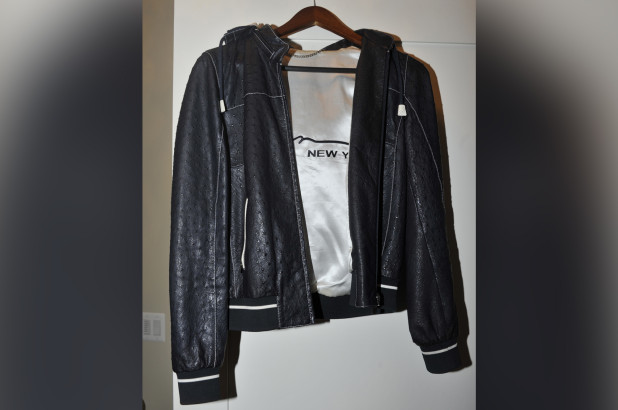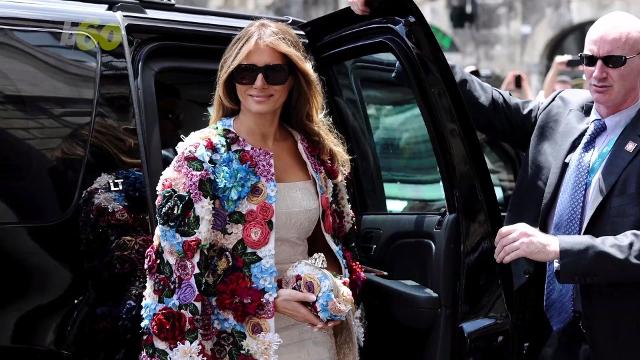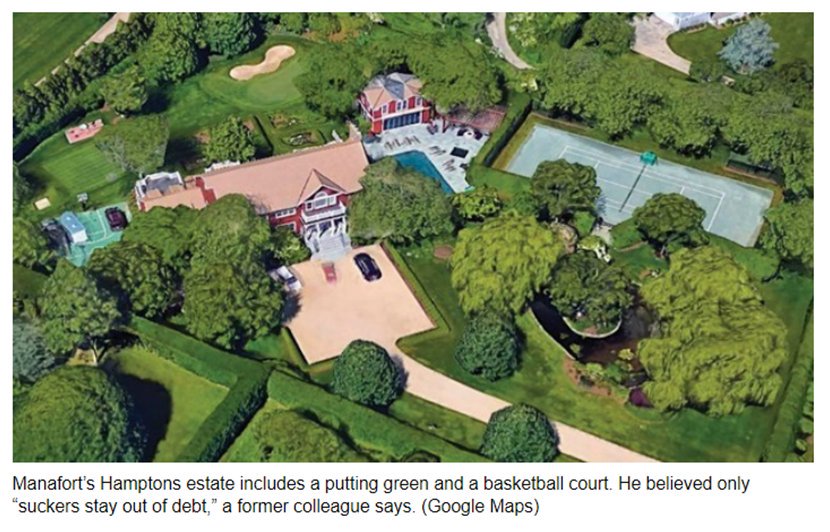Has a single garment ever gotten so much press commentary than Paul Manafort’s ostrich skin jacket? (Update: Yeah, okay, Monica’s blue dress.)
The jacket is infamous for costing $15,000 and still being ugly. I’m having a hard time visualizing Manafort wearing it, although I guess all the photos I’ve seen of him show him wearing a suit that looks like just about every other suit any man wears.
People have pointed out that the $15,000 pales in comparison to a $51,000 Dolce & Gabbana jacket worn by Melania awhile back.
To me, that looks like what might happen if the Etsy website got stomach flu. Yes, everybody says it’s a $51,000 jacket. No, I don’t know what kind of markup over cost is involved, but I suspect a lot. It has also been noted that Melania very rarely uses jacket sleeves. I assume the thing in her hand is a clutch of some sort and not some alien being expelled by the jacket.
Back to the ostrich jacket. Washington Post fashion editor Robin Givhan wrote,
Where to begin in the dumbfounding tale of Paul Manafort and his fashion habit? The gluttony. The indulgence. The preening bad taste.
The pathetic pretentiousness of it all.
His is the story of a man’s inexorable slide into a nauseating spectacle of insatiable consumption — a parable, or perhaps, a farce that included salivating merchants flying across the country to cater to his appetites. There are so many enticing, beguiling entry points in this story of unbridled decadence: the use of wire transfers from foreign bank accounts to pay his clothing bills, the capacity to spend more than $929,000 on suits in a five-year period, a perplexing fixation on plaid sport jackets. But ultimately, the one thing that most folks will remember from the first week of Manafort’s trial on bank and tax fraud charges is his $15,000 ostrich-leather bomber jacket.
Well, why not? The Manafort saga has a distinctively freak show quality to it. How does a man stash $30 million in offshore bank accounts and still go broke?
Mueller has alleged a years-long scheme of astonishing scope: that Manafort first laundered $30 million from a web of undeclared offshore accounts into the US without paying taxes on it, and then (after the Ukrainian money stopped coming in) defrauded several US banks to get more than $20 million in loans. Manafort has pleaded not guilty on all counts.
The man owns a lot of real estate, including a condo in Trump tower, another condo in Manhattan’s SoHo district, a brownstone in Brooklyn, an estate in the Hamptons, an unremarkable single-family home in Arlington, Virginia, and a home in Palm Beach, Florida. I understand that if he’s convicted, all those homes will be forfeited.
The man is 69 years old. He could have announced his retirement, sold some of that real estate to cover debt and still live more than comfortably for the rest of his life. Instead, he talked himself into the Trump campaign as a way back into the lobbying game. That’s how he got his start, years ago; he turned a mid-level position in the Reagan campaign into a big-ticket lobbying career.
The trial that began this past week was all about the money he earned working for Viktor Yanukovych, one-time president of the Ukraine, and several Russian oligarchs.
The first set of charges, which Mueller calls “the tax scheme,†relate to Manafort’s flush years, when the Ukrainian money was pouring in to the tune of tens of millions of dollars. Mueller says Manafort set up a complex web of offshore shell companies and then spent $30 million of that offshore cash in the US between 2008 and 2014.
About $12 million of that cash was allegedly spent on “personal items†for Manafort and his family, spread across more than 200 different transactions. This included about $5.4 million to a home improvement company in the Hamptons, $1.3 million tied to an antique rug store in Virginia, $849,000 or so to a men’s clothing store in New York, $819,000 on landscaping, and payments related to several Range Rovers and a Mercedes-Benz.
Then another $6.4 million was allegedly wired from offshore for three real estate payments: $1.5 million for a condo in New York City, $3 million for a brownstone in Brooklyn, and $1.9 million for a house in Virginia. On top of that, Manafort allegedly sent another $13 million as “loans†to US companies he controlled — but the government calls these loans “shams†designed to fraudulently reduce his taxable income.
There are allegations that he was wiring money from a bank in Cypress for “home improvements” that he didn’t actually buy. Money laundering?
The New York Times reports that Manafort wasted no time trying to monetize the Trump campaign gig, for which he was not paid:
In April 2016, just days after becoming a Trump campaign strategist, he tried to use his positive news media coverage as leverage in a debt dispute with a Russian oligarch, Oleg V. Deripaska.
“I assume you have shown our friends my media coverage, right?†Mr. Manafort wrote in an email to a business partner.
“Absolutely,†the partner, Konstantin V. Kilimnik, responded. “Every article.â€
“How do we use to get whole,†Manafort asked. The emails were reported by The Washington Post and The Atlantic.
Later, Mr. Manafort suggested providing campaign briefings to Mr. Deripaska. No evidence has emerged that such briefings occurred.
In short, no sensible person would have let Manafort anywhere near a presidential campaign. Apparently Trump was the one who hired him.
As Mr. Manafort ascended to one of the premier jobs in American politics, prosecutors now say, his career was privately in shambles. In early 2016, his accountant testified, he worked to mortgage some of his seven or eight homes. Prosecutors said he had become accustomed to a lavish lifestyle and was preoccupied with clinging to it.
Back to Robin Givhan and the ostrich jacket:
Prosecutors argued that the luxurious nature of Manafort’s purchases was important because it offered the jury insight into it their case. That Manafort “had an expensive lifestyle that required lots of money to maintain is important proof as to why he would commit the bank frauds,†prosecutors wrote. Manafort had grown accustomed to Bijan, ostrich and python and when his income declined “he resorted to bank fraud as a means to maintain his lifestyle.â€
Perhaps. But prosecutors missed a more significant argument. The fashion industry has long recognized and exploited the fact that its customers are not just buying accoutrements to a lifestyle. They are buying the building blocks to a public identity.
And when those blocks elevate a man to the tippy-top of the pyramid, he might do just about anything to prevent a perilous fall.
Apparently, the yawning emptiness that is Paul Manafort required a lot of accoutrements to maintain an identity.



